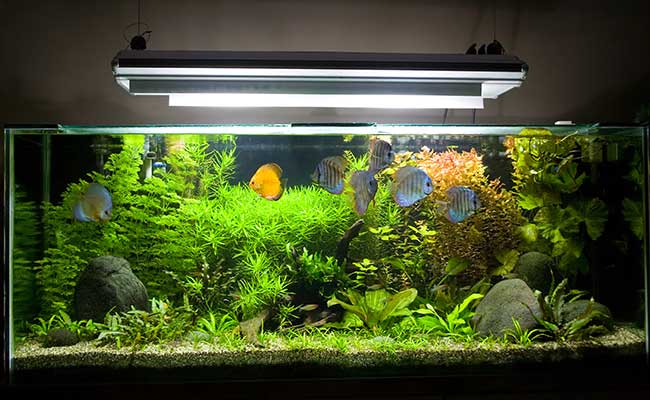You might have come across the phrase water column in online discussions.
That’s exactly how I stumbled across the phrase years ago, when I first entered the hobby.
And, when I googled:
What is a water column in aquariums?
It only brought up the water column in relation to oceans… Nothing related to aquariums.[1]
And, nothing there answered my question.
Years later, I see that this question still doesn’t have an online article dedicated to it – so I decided to write one myself!
Contents
What is the aquarium water column?
The phrase water column refers to all the water in your aquarium, from the top of your substrate, to the surface water – every last drop.
If your tank has no substrate, then the water column is from the bottom of the tank to the water surface.
To put it simply, the water column just refers to the water that sits inside your tank.
No pebbles, no plants, no fish, no aquarium equipment – just water.
It is important to note that when discussing the water column, it typically does not refer to water that sits in the pipes and filters.
If you were to draw imaginary lines in your tank, separating it into thirds, it would look like this:

That is the water column.
Not too difficult to understand, right?
I can understand where the confusion comes from… Below are two questions I came across in online forums:
1. How do I get rid of algae in my water column?
2. The water in my tank has algae, how do I get rid of it?
Well, it turns out that both of these people asked the same question.
My personal observation is that the term water column is more widely used by experienced hobbyists.
But the phrase ‘water column’ isn’t just used to identify the beginners from those who are more experienced…
It is also used when discussing exactly where a fish prefers to swim in your aquarium.
As you might have noticed with your own fish, different species prefer to swim at certain spots in your aquarium.
This is how the water column is most commonly used in discussion – in relation to where a fish spends most of its time.
Danios, Raspora and many Tetra, for instance, prefer the top level of the water column.
Angelfish, Platy and goldfish prefer the middle level of the water column.
And Pleco, Cory and Kuhli loach prefer the bottom level.
By paying attention to what fish swims in which section of the water column, you can build up an exciting community tank with fish inhabiting all areas of your aquarium – not just a single level. How cool is that?
Community tanks that take the water column into account are often much more exciting and pleasing to look at than those that don’t.
The Significance of Mastering Your Aquarium’s Vertical Space
I can’t stress enough how pivotal it is to grasp the nuances of your water column aquarium. Beyond just a body of water, it’s a multifaceted environment where each vertical layer has its own ecosystem.
Understanding this can significantly impact the wellbeing of your aquatic pets and the overall equilibrium of your aquarium.
Navigating the Complexity of Your Tank’s Layered Ecosystem
I think it’s vital to shed light on the less visible complexities hidden in the aquarium water column. These aren’t just layers of water; they’re separate yet interconnected zones, each with varying pH, temperature, and nutrient levels. Being attuned to these variations is like having a cheat sheet to aquarium management.
Why Depth Sampling Can Reveal Your Aquarium’s Secrets
Depth sampling isn’t just for scientists; I recommend it for any aquarium enthusiast. Taking water samples from the top, middle, and bottom of your water column aquarium will provide you with a comprehensive picture. This 360-degree assessment can be the linchpin to understanding what each section of your aquarium water column needs for optimal health.
The Artistic Influence of Aquascaping on Aquatic Zoning
Aquascaping is not solely about aesthetics; I feel it’s a form of functional art that shapes the very dynamics of your fish column. Strategically placed plants, rocks, and driftwood don’t just decorate; they also influence water flow and create distinct microenvironments within your aquarium water column. It’s artistic manipulation with a practical impact.
FAQs: Your Water Column Queries, Clarified
How does my choice of fish relate to the aquarium water column
Different fish species have preferences for specific layers within the fish column. Understanding these preferences allows you to create a dynamic, visually appealing tank that mimics natural habitats.
Could you clarify what is a water column in aquarium terminology?
The term “water column” refers specifically to the vertical body of water in your tank, separate from any substrate, plants, or equipment. It’s a multi-layered ecosystem in miniature, playing a crucial role in the wellbeing of your aquatic community.
Is it possible to modify conditions within the column aquarium?
Yes, indeed. The use of water pumps, aerators, and even heating elements can manipulate the conditions within your column aquarium, leading to a healthier, happier aquatic environment.
Do ‘dead spots’ exist in a column aquarium?
Unfortunately, they do. These are zones with insufficient water flow, and they can be trouble spots for algae and waste accumulation. Monitoring the water flow in your aquarium water column is essential for preventing these problem areas.
Understanding your aquarium’s vertical spaces is more than an advanced hobbyist’s game—it’s the doorway to a more harmonious, vibrant aquatic environment.
Conclusion
If you made it this far, you should now have a complete understanding of the water column. Now, use it in a conversation today!

Ian Sterling, founder of Fishlab.com, began his aquarium journey over 30 years ago, driven by a deep fascination for fish and their diverse personalities. His website, Fishlab.com, is dedicated to making fishkeeping accessible and enjoyable, offering beginner-friendly guidance, expert insights, and a community for aquarists to connect and share experiences.



Comments (6)
Completely wrong I’m afraid, you really need to establish a good rapport between giving advice with regards to knowing the subject matter.
Hi Cyril,
Your comment provides no clarity and does little but insult. If you know better, then why don’t you share your expertise on the topic? I would love to know where the article went wrong so that I can improve it!
Cyril,
I’m not really sure why you made the statement that you did. This article simply describes what people are referring to when they speak about a water column. I think the post was clear and concise as well as being basic enough for a beginner to understand. I also liked the examples of where different fish like to hang out in the column.
Please explain your displeasure more.
*background on me* I worked for a company that builds, calibrates and instructs end users on deep sea test equipment for 7 years as a repair and calibration tech and as a traveling instructor. Can’t forget my 22 year as an M1A1 Abrams crewman but that isn’t as relevant to this discussion…
Hi Ian. I’m at my wits end. PLEASE. I cannot keep my 29 gal tank sparkling clear. I have done three water changes the first 75% the last two 50 %. My Ammonia is fine water has been tested. My suction tube has removed a lot of fish matter in the beginning and now that part is clean. I do have two artificial plants that were cleaned when purchased. There is no direct sunlight entering the tank and my tank light is on only for a few hours.
Hi George,
If you want truly crystal clear water you would need a filter capable of removing all the finest pieces of grit. Often called a polishing pad (50um) these can trap all the tiny bits of gunk that slip through your more coarse filter and can clean up the water, assuming it’s debris. If it’s free-flaoting algae, then you’ll gave to treat the cause. A UV sterilizer can help if that’s the case.
Ian I also wanted to mention that my tank is over 20 yrs old